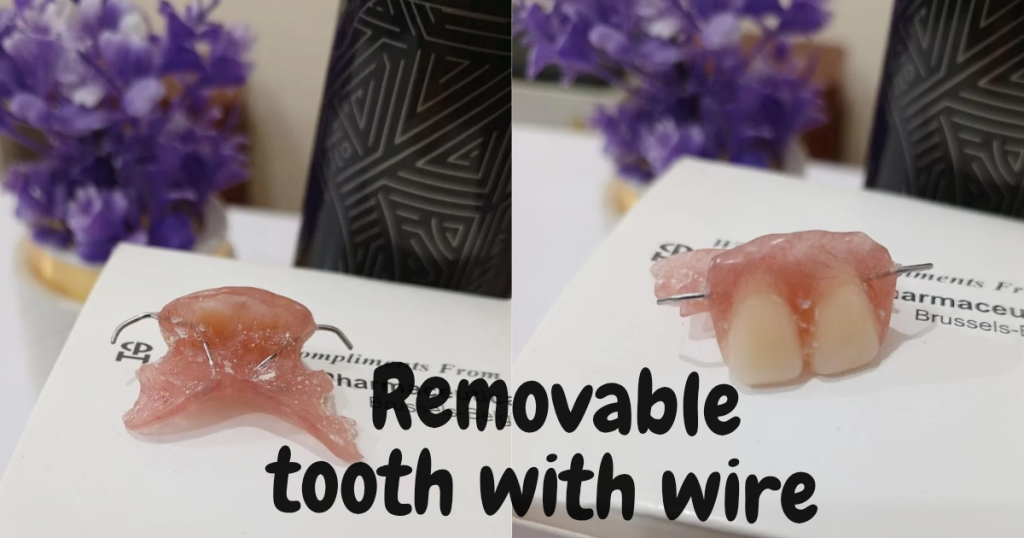Physical Address
304 North Cardinal St.
Dorchester Center, MA 02124
Physical Address
304 North Cardinal St.
Dorchester Center, MA 02124

Missing a tooth can knock your confidence, but what if there’s an easy, pop-in-pop-out fix that doesn’t break the bank or require surgery? A removable tooth,(“Removable tooth can sometimes feel a bit loose in the patient’s mouth, so that’s why wires or clasps are often added.”)with wire—commonly known as a partial denture or flipper with metal clasps—is a lightweight prosthetic designed to replace one or a few missing teeth, using slim wires to hook onto your natural ones for a snug, secure fit. It’s perfect for temporary gaps from extractions, accidents, or as a budget-friendly alternative to implants, restoring your smile’s look and function without the commitment. In this newbie-friendly basics guide, we’ll break down exactly what it is, how it works, pros and cons, and simple tips for getting started. Ready to reclaim that grin? Dive in!
What Exactly Is It?
This device is a removable partial denture (RPD) made from acrylic or plastic bases with fake teeth attached, plus metal wire clasps that grip your existing teeth for stability.It’s custom-fitted to your mouth, often used when you’ve lost a tooth or two but still have healthy ones around. Unlike full dentures, it’s just for partial gaps.
There are two types of Removeable tooth:
1.Self cure
2.Heat cure
How Does It Work?
The wire clasps—usually made from chrome-cobalt or stainless steel—clip onto adjacent teeth like little anchors, keeping the prosthetic in place while you eat or talk.You pop it in during the day and remove it at night for cleaning. It restores chewing power and prevents remaining teeth from shifting into the empty space.
Pros That Make It Worth Considering
It’s super affordable compared to implants, non-invasive with no drills or surgery, and easy to adjust or repair. Plus, it boosts your appearance quickly, helping with speech and confidence without waiting months for healing.
The Downsides to Keep in Mind
On the flip side, it might feel bulky at first, causing sore spots or extra saliva.Clasps can trap food, upping plaque risk, and it may wear on natural teeth over time. Maintenance is key, as they can break if dropped.
Getting One: The Simple Process
Your dentist takes impressions of your mouth, designs the piece in a lab (takes 1-2 weeks), then fits it with adjustments for comfort. Expect a couple of visits—quick and painless. In 2025, digital scans make it even faster and more precise.
Everyday Care Tips
Remove it nightly and soak in denture cleaner or mild soap water—avoid hot water to prevent warping. Brush gently with a soft brush, rinse after meals, and store in a case. See your dentist every 6 months for tweaks.
Cost Breakdown for Budgeting
Basic ones start at $226 for acrylic with clasps, but full setups run $800-$2,500 depending on materials and complexity.Insurance often covers part if it’s restorative—check for dental discount plans to cut costs.
Alternatives If It’s Not Your Fit
If wires bug you, try flexible partials without metal or fixed bridges cemented in place.For permanence, dental implants offer a natural feel but cost more and involve surgery.
FAQs About Removable Teeth with Wire
How long do they last?
Typically 5-10 years with good care, but clasps might need replacing sooner.
Do they hurt to wear?
Initial discomfort is common, like sore gums, but it fades in a week—use wax on clasps for relief.
Can I eat anything with it?
Most foods yes, but start soft and avoid sticky or hard items to prevent damage.
Are the wires visible?
Depends on placement—back teeth hide them better, but modern designs make them discreet.
Is it okay for kids or teens?
Sure, especially for temporary use during growth, but consult a dentist for fit.
Wrapping up, a removable tooth with wire might just be the straightforward, wallet-friendly hero your smile needs—slipping in to fill gaps, boost confidence, and let you chew and chat without missing a beat, all while giving you time to weigh permanent options,(“Some folks who aren’t really clued in on the whole process of getting replacement teeth often go for removable dentures as their first choice. I mean, they’re usually way more affordable and can be whipped up pretty quickly if you’re in a pinch.”).For new users, starting with proper fit and care turns it from a temp fix to a reliable daily ally. If this basics rundown has you ready to explore, chat with your dentist about customizing one for you.